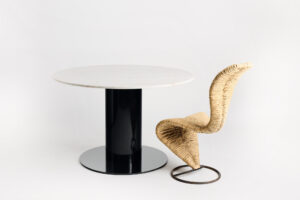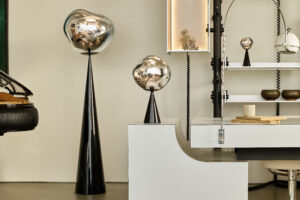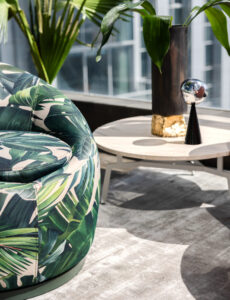Tom Dixon is one of the most intriguing and respected names in contemporary design, due in no small part to the fact that his personal story is far from cliché. He was born in Tunisia to British parents but moved to London in his childhood, growing up amidst a changing cultural landscape, music, protest, and innovation. His design career did not begin on a drafting table at an academy, but rather on a side street in London. At the age of 22, while riding a motorcycle, he had a serious accident that nearly cost him his life and completely ended his musical ambitions. Until then, he had played bass in various bands and even performed briefly with the Dexys Midnight Runners, who were then on the verge of global success.
Recovering from the accident and forced to give up the bass, he found himself with idle time and a broken dream. Instead of sinking into self-pity, he began welding, at first just to fix his bike, but soon welding became a form of expression and, unexpectedly, a new path.
Dixon began collecting scrap metal across the city, dismantling bikes, gates, and old frames, and building objects from them, shelves, chairs, tables. What started as a rough hobby turned into a fascinating material journey driven by an increasing obsession with metal, its weight, texture, malleability, and how it interacts with light. He quickly realized he didn’t need a diploma to be a designer, he simply was one. No formalities, no academic boundaries (a bit like Niso). In 1983, he started creating furniture independently and selling it out of a small space in South London. These were works unlike anything seen at the time, raw, constructivist, and dependent on their internal skeletons like living organisms.
 Young Tom Dixon on one of his earliest chair designs. raw, linear, full of expression.
Young Tom Dixon on one of his earliest chair designs. raw, linear, full of expression.
A Rebirth as a Designer
What shaped Dixon’s distinctive path was the fact that he is a self-taught designer, an artist who taught himself the intricacies of the craft along the way. In the early 1980s, as the post-punk scene in London thrived, Dixon experimented with welding scrap parts into experimental furniture. His DIY approach perfectly echoed the spirit of the post-punk era. He made twisted steel chairs, rough iron tables, and even light fixtures from metal parts that looked like they came from a junkyard. These pieces, like the now-famous S-Chair designed for Cappellini and the Pylon Chair, gained attention in avant-garde design circles but initially earned him very little money. Though quickly recognized as an emerging talent with a rebellious style, commercial success didn’t come immediately. This may have been one reason he decided to open his own showroom, called Space, to sell his creations directly to the public.
 The sculptural S-Chair that placed Dixon firmly on the global design map
The sculptural S-Chair that placed Dixon firmly on the global design map
An Obsession with Material and Process
Dixon’s work reveals an almost scientific obsession with materials and the ways they can be harnessed for design. He experimented with a variety of materials, from heavy metals to plastic and glass—and always sought to expose the raw beauty within. Dixon describes himself as a “vertebrate designer,” one who designs from the inside out, from the structure to the surface. Structure and material come before form in his process, unlike designers who start with external aesthetics. In his chairs and sofas, the inner framework is often visible or at least felt beneath the upholstery. His lighting fixtures also possess a strong material presence, lamps combining cast brass, forged metal, or hand-blown glass in ways that reveal the manufacturing process. He’s known for saying that his design grows from the “bones” of the object, which explains the weight and physicality of his creations.

 Tom Dixon early in his journey, surrounded by raw materials and experimentation, where it all began.
Tom Dixon early in his journey, surrounded by raw materials and experimentation, where it all began.
Iconic Lighting: Sculpting Light and Shadow
One of the most distinctive aspects of Tom Dixon’s work is his lighting design. Among his standout collections, Melt is perhaps the most dramatic – a series of lighting fixtures that look like molten glass frozen mid-flow. When switched off, they appear as opaque metallic forms; once illuminated, they become semi-transparent, revealing an organic, distorted interior that reflects their surroundings in fascinating ways. Melt fixtures are made of polycarbonate with a metallic finish, allowing for striking effects of light, depth, and reflection. The series, developed in collaboration with the Swedish design studio Front, is available in pendant, floor, table, and wall versions – all bearing Dixon’s unmistakable material signature.
The Bell collection reveals another side of Dixon’s design language – precise, minimalist, and almost futuristic. The lamp’s body is crafted from polished metal in chrome, gold, or copper finishes, reflecting its surroundings like a perfect mirror. Its dome-like shape recalls an upside-down umbrella, simple at first glance, yet full of presence. While Melt speaks in a soft, flowing tone, Bell is defined by clean lines and geometric clarity. It manages to be both bold and quietly elegant, depending on the angle and the space. At Niso, Bell introduces moments of focused stillness, a metallic pause within richly textured interiors.
 Lighting fixtures from Dixon’s Melt series.
Lighting fixtures from Dixon’s Melt series.
Beyond Melt and Bell, Dixon’s collections like Pose, Stone, and Press showcase his command of materials like stone, glass, and metal. Each lighting piece is a sculptural object with presence, reinforcing his status as a global powerhouse in contemporary lighting design.


 Tom Dixon seated on the Fat office chair – relaxed, rounded, just as he designed it.
Tom Dixon seated on the Fat office chair – relaxed, rounded, just as he designed it.
The Natural Connection Between Niso Adut and Tom Dixon
The connection between Dixon and Niso was born from a precise search for a brand that complements, and elevates, what Niso has been doing for five decades: curating total design. If Niso specializes in bold, sculptural furniture, Dixon brings innovative lighting and investigative materiality that expands the boundaries of the home. We initially chose to bring him in for his remarkable lighting, but also for the unique accessories our audience was looking for, glass kitchen objects, contemporary resin pieces, and more. All of these speak the same material language as Niso, enriching the story we tell.
This shared language is also visible in the physical space. In our showroom, it’s common to see effortless pairings between locally designed furniture and Dixon’s lighting. In the image below, for example, the Duba armchair and Flower table with a marble finish are paired with an outdoor rechargeable Melt lamp. Everything fits together in surprisingly seamless harmony, as if it were all designed for the same space. And speaking of names—if we have the Duba collection, Dixon has the Fat collection. It’s a dialogue of form and presence.
Interestingly, when we first decided to import Tom Dixon, we started cautiously with a small order. We didn’t expect the Israeli audience to connect so quickly. But as soon as the products were displayed, especially the lighting—orders began pouring in, and we were truly surprised. Turns out, Dixon’s visual language speaks fluent Hebrew too.
 Outdoor set: Duba armchair, Marble Flower coffee table, portable Melt lamp.
Outdoor set: Duba armchair, Marble Flower coffee table, portable Melt lamp.
Beyond the material language and aesthetic pairings, there’s a deeper, almost biographical connection between Niso Adut and Tom Dixon. Both came from the street, not from elite design institutions. Dixon turned to welding from sheer boredom after a motorcycle accident, and Niso, a young Bulgarian growing up in Jaffa who wasn’t exactly the star student, found himself in Florentin at age 18, almost by accident, building furniture. Neither had a master plan, just a relentless urge to work with their hands, to make something useful, to earn a living, and to put their soul into it. Maybe that’s why the connection feels so natural, beneath all the brass, leather, glass and stone, there’s the same human drive to create something good, from scratch.


 Niso’s designs alongside Tom’s, a combination that feels natural, as if they were always meant to be together.
Niso’s designs alongside Tom’s, a combination that feels natural, as if they were always meant to be together.
Furniture That Makes a Statement
Alongside lighting, Tom Dixon has made a strong mark in furniture design. The Fat collection features rounded, minimalist armchairs with a playful edge. Wingback chairs reinterpret a British classic with tall, sweeping lines and a modern twist. The Slab series, crafted from solid wood, highlights material weight and joinery precision, while Swirl, made from colorful resin, adds a graphic punch to interior corners. All of these are now available on our website, for those seeking furniture that is both a statement and a daily pleasure.
Dixon’s designs demand attention but remain functional and comfortable. That may be his greatest strength, blending sculpture with everyday use. His lighting fixtures, for example, feel like works of art when off and offer precise, intelligent light when switched on. The use of durable materials, refined construction, and timeless form keeps his pieces relevant year after year. In the end, Dixon’s touch lies in the balance between raw materiality and modern elegance, with a design wink and deep understanding of real needs. From Niso’s perspective, he’s a natural partner, each of his pieces is not just a product, but a story: design born from material, built by hand, and made to last.






 Young Tom Dixon on one of his earliest chair designs. raw, linear, full of expression.
Young Tom Dixon on one of his earliest chair designs. raw, linear, full of expression. The sculptural S-Chair that placed Dixon firmly on the global design map
The sculptural S-Chair that placed Dixon firmly on the global design map Tom Dixon early in his journey, surrounded by raw materials and experimentation, where it all began.
Tom Dixon early in his journey, surrounded by raw materials and experimentation, where it all began. Lighting fixtures from Dixon’s Melt series.
Lighting fixtures from Dixon’s Melt series. Tom Dixon seated on the Fat office chair – relaxed, rounded, just as he designed it.
Tom Dixon seated on the Fat office chair – relaxed, rounded, just as he designed it. Outdoor set: Duba armchair, Marble Flower coffee table, portable Melt lamp.
Outdoor set: Duba armchair, Marble Flower coffee table, portable Melt lamp. Niso’s designs alongside Tom’s, a combination that feels natural, as if they were always meant to be together.
Niso’s designs alongside Tom’s, a combination that feels natural, as if they were always meant to be together.